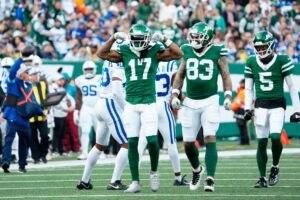Kirk Cousins has always had impressive statistics. The issue, of course, is that not all statistics are created equal. Minnesota Vikings fans should know this after two years of watching Cousins. As LWOS writer Kyle Granger very rightly explains, “statistics are useless without context,” a statement that is as true of Granger’s assessment of Von Miller as it is for our assessment of Cousins.
Kirk Cousins Statistics
By any number of statistics, Kirk Cousins had a strong 2019 season. Cousins, according to Pro Football Reference, had a 69.1 completion percentage, 3,603 passing yards, 26 touchdown passes, and six interceptions. He had a 107.4 passer rating, fourth-best in the NFL. Most importantly, Cousins led the Vikings to 10 wins.
Even Cousins’ more advanced statistics are impressive. NFL Next Gen Stats provides an informative season chart that tracks his throws across the entire season. Apart from one area of the field, Cousins is either average to far above average. Perhaps the most surprising detail from the Next Gen chart is that Cousins is considerably better at completing deep sideline passes than most quarterbacks. The NFL average for the deep-left section is 75.3 and 78.0 for deep right. Next-Gen Stats gives Cousins a formidable 116.2 and 133.8. For context, Patrick Mahomes has a 110.4 deep-left score and 98.8 deep-right score. No one is arguing that he is a better quarterback than Mahomes, but it’s certainly notable that (at least according to NFL Next Gen Stats) Cousins put forward a better performance than Mahomes in throwing to some key deep areas of the field.
Pro Football Focus gives Cousins similarly strong grades. In PFF’s grading system, Cousins is 2019’s sixth-best quarterback (one spot ahead of Aaron Rodgers and two ahead of Matthew Stafford). His 84.2 PFF score is easily the best of his career. Recently, PFF published an article outlining what each quarterback needs to accomplish in order to have success in 2020. PFF simply recommends that Cousins repeat his 2019 performance – complete with plenty of play-action passes and designed rollouts – to be successful in 2020.
The statistics from Pro Football Reference, NFL Next Gen Stats, and PFF all suggest that Kirk Cousins had a strong 2019 season. In many ways, Cousins did have a strong year. Rising from merely being a good quarterback to becoming an elite quarterback, though, will require Cousins to cultivate a different relationship with his impressive statistics. Indeed, Kirk Cousins needs to consistently put forward meaningful statistics in the most important situations.
The 2019 Examples
Take, for instance, a couple of examples from last season.
At the end of Week 2, the Vikings had the chance to complete an improbable comeback against the Green Bay Packers. The Vikings were in a 21-0 deficit at the beginning of the second quarter, but at the end of the fourth, they were only down 21-16. The Vikings had the ball at the eight-yard line with a little more than five minutes to play. On first down, Cousins (under some pressure in spite of the designed rollout) inexplicably lobbed the ball into double coverage, leading to a game-sealing interception for the Packers. Throwing an interception at that moment – after clawing back into a road game against a divisional rival (and on first down, I hasten to add) – was backbreaking. That interception impacted the Vikings’ ability to win far more than most turnovers.
The inverse is also true, though.
In Week 11, Denver Broncos receiver Courtland Sutton was creating all kinds of problems for Minnesota’s secondary. Not only was he consistently beating Xavier Rhodes, Sutton even completed a 38-yard pass. When Sutton completed his 38-yard pass, Minnesota only had 13 passing yards. It was ugly, folks. The Vikings began the second half down 20-0, almost the exact same deficit as the Packers game. Over the course of the second half, the Vikings again chipped away at the opposing team’s lead. Though they were not without mistakes (a boneheaded offside on fourth and three to extend a Denver drive, more sacks, and a failed two-point conversion), the Vikings found themselves in a position to win late in the fourth quarter. On first down with a little more than six minutes to play, Cousins moved to his left on a designed rollout. He completed a 32-yard touchdown pass to Kyle Rudolph. The Vikings won 27-23. Cousins’ late touchdown pass meant far more than the vast majority of his other twenty-five touchdown passes.
The 2020 Season
At the beginning of training camp, Cousins was asked about his main takeaway from the San Francisco 49ers playoff loss. Cousins explained that he needs to perform better in clutch moments: “One of the focuses for me this season will be to, you know, if we’re not running the ball well and if things aren’t going well, to be able to make those plays that can get us right back in the game, and win a game.” Cousins mentioned the Denver game before suggesting that coming back against below-average teams isn’t the key. “Being able to do that more and against a team like San Francisco,” Cousins went on to explain, is a primary “goal.” In other words, Kirk Cousins recognizes that he needs to squeeze the most value possible out of his statistics.
The Vikings made the right decision by extending Cousins’ contract, but it’s no longer adequate to merely be a good quarterback, especially with so much uncertainty on defense. Cousins, by his own admission, needs to do a better job of scrambling to give himself more time and of completing off-schedule plays. If Cousins is successful – especially in the early weeks when Mike Zimmer’s defense is still getting its footing – then the Vikings may finally be ready to contend for a Super Bowl.






